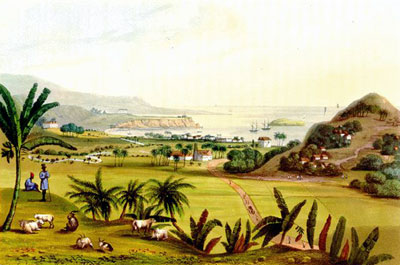|
Introduction
On
the recommendation of Whig contacts in the anti-slavery
movement, including William Wilberforce’s successor, Thomas
Fowell Buxton, Madden was among the first Irish Catholics
appointed, after the 1829 Act removed barriers to the
employment of Catholics in the British public service.
[1] Although he had no legal background,
as a medical practitioner, Madden had witnessed slavery
in the Middle East under the Ottoman Empire, making him
uniquely qualified for what would become the first in
a series of dangerous human rights missions. A native
of Dublin with a thriving medical practice in London’s
fashionable Mayfair, Madden abandoned his career as a
physician to devote himself full-time to the anti-slavery
cause. In October 1833, accompanied by his English wife,
Harriet, he boarded the Eclipse at Falmouth and
set sail for the British West Indies.
|

A
painting of Jamaica representing what the island
looked like when Madden, and the other five
Special Magistrates, landed there in November
1833; their arrival provoked intense hostility
from planters.
|
Madden
was one of six Special Magistrates who landed in Jamaica in November 1833, where their arrival provoked
intense hostility from planters. No sooner had the select
band set foot on the island than they experienced rumblings
underground, described by Madden as ‘a harbinger which
was considered an appropriate introduction for persons
with our appointments’ (Madden 1835: 80). These earth
tremors did indeed foreshadow the effect the newcomers’
mission had on the island’s status quo.
Any
expectations they might have entertained regarding the
reception awaiting them were shattered by the headlines
in the local newspapers. According to one editorial, the
Secretary of State, Lord Stanley, had sent a crowd of
‘sly, slippery priests from Ireland’ to support themselves
on the poor colonists. The press embellished their reports
with a biblical reference labelling them as ‘strangers,
plunderers, and political locusts’. Interference on the
part of these newcomers was disrupting the peace of the
island by promoting ‘disorder and confusion’ with their
‘insidious practices and dangerous doctrines’ (Madden
1835: 33).
Among the enslaved population, however, the reaction was
altogether different. From their perspective, the magistrates
were sent to the island as saviours who would deliver
them from bondage. There was a palpable sense of excitement,
as everyone eagerly anticipated Emancipation Day, set
for ‘the 1st of August’ of the following year.
Losing
no time, Madden was officially sworn in as Special Magistrate
by Lord Mulgrave and settled into his duties in St. Andrew’s
parish, an area of approximately 455 square kilometres
just north of Kingston.
[2] From there
he transferred to the City of Kingston, the island’s commercial
and administrative centre, when this important region
was placed under his jurisdiction.
|

A
painting of the city of Kingston
around 1833.
Kingston
was
Jamaica’s commercial and administrative centre where
Madden was officially sworn in as Special
Magistrate by Lord Mulgrave.
|
Madden’s tenure was marked by illness, controversy, and
violence. Within nine months of their arrival, yellow
fever and other tropical diseases caused the untimely
demise of four of the special magistrates who had accompanied
Madden on the Eclipse. Evidently, the Irishman’s
medical training and standards of hygiene inoculated him
from the ravages of disease as he adapted to the unfamiliar
climate.
On
what he later described as the proudest day of his life
(Madden 1891), Madden was present for the historic Emancipation
Day Proclamation, delivered by Lord Mulgrave, in Spanish
Town, Jamaica, on 1 August 1834. Far from disturbing the
peace of the island as the authorities had feared, slaves
celebrated the occasion with church services and ‘a quiet
and grateful piety.’
[3] According to
the provisions of the Emancipation Act, by way of compensation,
the government had earmarked £20 million (more than
£800 million in today’s currency) to be paid to
former slave owners for loss of ‘property’. Slaves younger
than six years of age were to be freed, while those six
years and older were required to serve a term of apprenticeship
designed to teach them how to behave in freedom, or, as
the Act stipulated, ‘to accustom themselves, under appropriate
restraints, to the responsibilities of the new status’
(Temperley 1972: xi). Under threat of corporal punishment,
house slaves were required to serve a period of four years;
praedial slaves had to serve a period of six years, in
what amounted to little more than a system of modified
slavery.
During
one of his numerous trips around the island, Madden set
out for St. Mary’s Parish to find the location of a small
plantation property known as Marley that had
once belonged to a distant relative long since deceased.
At the end of an exhausting day’s ride in the verdant
mountains, whose heavily wooded areas and limestone soil
had sustained countless runaway slaves, he discovered
what appeared to be the abandoned remains of the old Marley
plantation. Making his way along the narrow, mostly overgrown
path, he encountered three women, former slaves, who had
been living in the dilapidated old house for many years.
To his astonishment, the two younger, middle-aged women
turned out to be the daughters of Madden’s great-uncle,
Theodosius Lyons, the previous plantation owner. He could
even see a strong family resemblance, and the elderly
woman was their mother. As the story unfolded, the sisters
described how, following the sudden death of the plantation
manager, their younger brother was sold to pay off the
debts of the estate.
|



